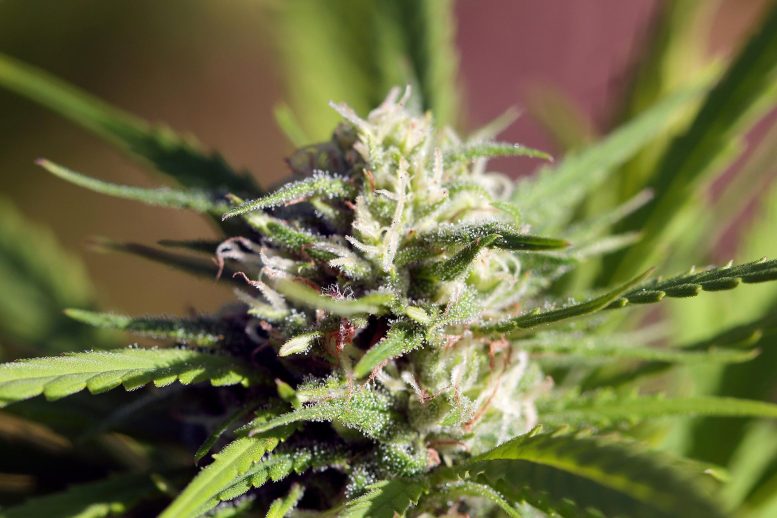
Researchers found a new group of prenylated volatile sulfur compounds (VSCs) responsible for the distinctive skunky smell of cannabis.
As cannabis is legalized in more areas, it has become increasingly popular as a medicinal and recreational drug. This plant produces a pungent, skunk-like odor that is pleasing to some but repulsive to others. Now, researchers reporting in ACS Omega have discovered a new family of prenylated volatile sulfur compounds (VSCs) that give cannabis its characteristic skunky aroma. The findings open up opportunities to investigate the molecules for medicinal benefits, the researchers say.
Cannabis sativa L. produces more than 200 known aroma compounds. Prior studies have focused mainly on terpenoids — molecules that range in odor from fuel-like to woody, citrusy or floral. Different cannabis cultivars have diverse mixtures of these compounds that contribute to their unique aromas. However, although terpenoids are the most abundant aroma compounds in cannabis, there is little evidence that they provide the underlying skunk-like smell of many cultivars. Skunks use several VSCs in their smelly defense sprays, so Iain Oswald and colleagues suspected that there could be similar molecules in cannabis. The team decided to use sensitive analytical techniques to find out.
The researchers analyzed flowers from 13 cannabis cultivars using a custom-built 2D gas chromatography system with three different types of detectors. Then, a four-person panel ranked the pungency of the cultivars on a scale from 0 to 10. The most pungent one, called Bacio Gelato, had the highest concentration of VSCs. The team identified seven VSCs in this cultivar, some of which were also present in other cultivars. Five of the VSCs contained the prenyl functional group and had skunk-like or sulfuric aromas. One compound in particular, 3-methyl-2-butene-1-thiol, referred to as VSC3, was the most abundant VSC in the cultivars that the panel reported to be most pungent. This compound has previously been implicated in the flavor and aroma of “skunked beer” — beer that goes bad after being exposed to UV light.
To confirm that VSC3 was the main source of the skunk-like aroma, the team added it to a mixture of 10 other major aroma compounds from cannabis, producing a combined odor very similar to the characteristic scent of cannabis. They also detected VSC3 in cannabis concentrates, such as those used for vaping. Finally, in greenhouse experiments, the researchers determined that the prenylated VSCs increased significantly toward the end of the flowering stage of cannabis growth, reached a maximum during curing and then dropped substantially after 10 days of storage. Because the molecular structures of the VSCs resemble compounds from garlic that have anti-cancer and cardioprotective effects, the new family of prenylated odor molecules should be investigated for medicinal properties, the researchers say.
Reference: “Identification of a New Family of Prenylated Volatile Sulfur Compounds in Cannabis Revealed by Comprehensive Two-Dimensional Gas Chromatography” by Iain W. H. Oswald, Marcos A. Ojeda, Ryan J. Pobanz, Kevin A. Koby, Anthony J. Buchanan, Josh Del Rosso, Mario A. Guzman and Thomas J. Martin, 12 November 2021, ACS Omega.
DOI: 10.1021/acsomega.1c04196
The authors do not acknowledge any external funding sources for this study. Three of the authors have filed a patent related to the findings.
The American Chemical Society (ACS) is a nonprofit organization chartered by the U.S. Congress. ACS’ mission is to advance the broader chemistry enterprise and its practitioners for the benefit of Earth and all its people. The Society is a global leader in promoting excellence in science education and providing access to chemistry-related information and research through its multiple research solutions, peer-reviewed journals, scientific conferences, eBooks and weekly news periodical Chemical & Engineering News. ACS journals are among the most cited, most trusted and most read within the scientific literature; however, ACS itself does not conduct chemical research. As a leader in scientific information solutions, its CAS division partners with global innovators to accelerate breakthroughs by curating, connecting and analyzing the world’s scientific knowledge. ACS’ main offices are in Washington, D.C., and Columbus, Ohio.









Optimize indoor air quality, the ionic paint additive by Air-ReNu permanently Eliminates, Smoking Odors, Airborne Pathogens, Pet urine odors, without using electricity, fans, or filters, check it out.
Marijuana is not a drug. It’s a medicinal herb, among the safest and most useful in history.
Drugs are man-made, cooked up in labs, for the sake of patents and profits tied to them.
And herbs don’t imitate drugs. Drugs imitate herbs, with decidedly mixed results. Check out the lists of cautionary notes and disclaimers printed in mini-type on the back labels of bottles of prescription drugs. And THEN research ‘marijuana’.
No one should promote the canard that marijuana is dangerous, like pharmaceutical drugs. Or even that it is a ‘drug’, except in Merriam-Webster’s third and broadest definition, as something which alters the mind. By that definition, religion and television (‘the plug-in drug’) should also be included.
“The Nixon campaign in 1968, and the Nixon White House after that had two enemies: the anti-war left and black people. We knew we couldn’t make it illegal to be either against the war or black, but by getting people to associate the hippies with marijuana and blacks with heroin, and then criminalizing both heavily, we could disrupt those communities. We could arrest their leaders, break up their homes, break up their meetings, and vilify them night after night on the evening news. Did we know we were lying about the drugs? Of course we did.” –John Ehrlichman
Prohibition of cannabis is a premise built on a tissue of lies: Concern For Public Safety. Our new laws save hundreds of lives every year, on our highways alone. In November of 2011, a study at the University of Colorado found that in the thirteen states that decriminalized cannabis between 1990 and 2009, traffic fatalities have dropped by nearly nine percent—now nearly ten percent in Michigan—more than the national average, while sales of beer went flat by five percent. No wonder Big Alcohol opposes it. Ambitious, unprincipled, profit-driven undertakers might be tempted too.
No one has ever died from an overdose of cannabis. It’s the most benign ‘substance’ in history. Most people—and particularly patients who medicate with cannabis–use it in place of prescription drugs or alcohol.
Cannabis has many benefits, most of which are under-reported or never mentioned in American newspapers. Research at the University of Saskatchewan indicates that, unlike alcohol, cocaine, heroin, or Nancy (“Just say, ‘No!’”) Reagan’s beloved nicotine, c is a neuroprotectant that actually encourages brain-cell growth. Researchers in Spain (the Guzman study) and other countries have discovered that it also has tumor-shrinking, anti-carcinogenic properties. These were confirmed by the 30-year Tashkin population study at UCLA.
And so ‘Marijuana’ turns out to be the most benign and versatile herb in history. “Cannabis” in Latin, and “kanah bosm” in the old Hebrew scrolls, quite literally the Biblical Tree of Life, used by early Christians to treat everything from skin diseases to deep pain and despair. Why despair? Consider the current medical term for cannabis sativa: a “mood elevator”. . . as opposed to antidepressants, which ‘flatten out’ emotions, leaving patients numb to both depression and joy.
The very name, “Christ” translates as “the anointed one”. Well then, anointed with what? It’s a fair question. And it wasn’t holy water, friends. Holy water came into wide use in the Middle Ages. In Biblical times, it was used by a few tribes of Greek pagans. And Christ was neither Greek nor pagan.
Medicinal oil, for the Prince of Peace. A formula from the Biblical era has been rediscovered. It specifies a strong dose of oil from kanah bosom, ‘the fragrant cane’ of a dozen uses: ink, paper, rope, nutrition. . . . It was clothing on their backs and incense in their temples. And a ‘skinful’ of medicinal oil could certainly calm one’s nerves, imparting a sense of benevolence and connection with all living things. No wonder that the ‘anointed one’ could gain a spark, an insight, a sense of the divine, and the confidence to convey those feelings to friends and neighbors.
Me? I’m appalled at the number of ‘Christian’ politicians, prosecutors, and police who pose on church steps or kneeling in prayer on their campaign trails, but cannot or will not face the scientific or the historical truths about cannabis, Medicinal Herb Number One, safe and effective for thousands of years, and celebrated as sacraments by most of the world’s major religions.